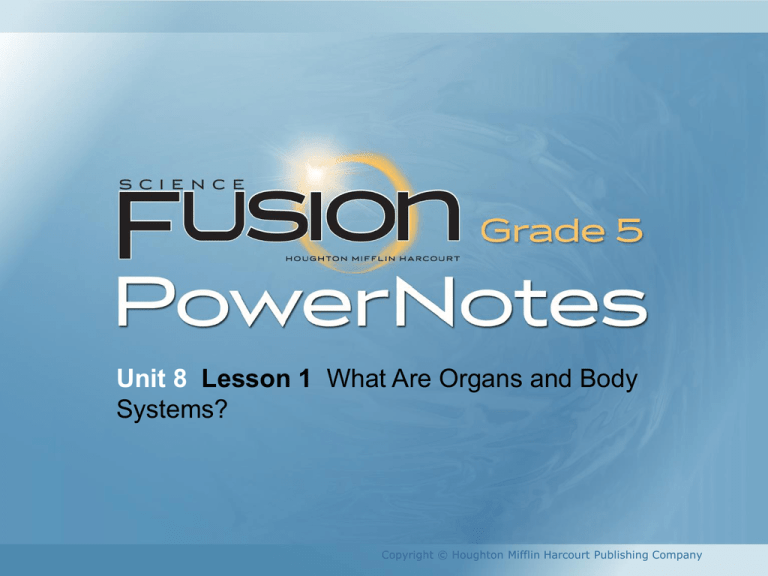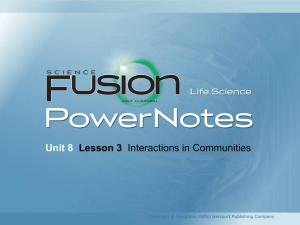Unit 8 Lesson 1
advertisement

Unit 8 Lesson 1 What Are Organs and Body Systems? Copyright © Houghton Mifflin Harcourt Publishing Company Unit 8 Lesson 1 What Are Organs and Body Systems? Florida Benchmarks • SC.5.L.14.1 Identify the organs in the human body and describe their functions, including the skin, brain, heart, lungs, stomach, liver, intestines, pancreas, muscles and skeleton, reproductive organs, kidneys, bladder, and sensory organs. • SC.5.L.14.2 Compare and contrast the function of organs and other physical structures of plants and animals, including humans, for example: some animals have skeletons for support—some with internal skeletons, others with exoskeletons— while some plants have stems for support. Copyright © Houghton Mifflin Harcourt Publishing Company Unit 8 Lesson 1 What Are Organs and Body Systems? Building a Body • An organism is a living thing. • An organism is made of parts that work together to meet its needs. • An organ is a body part that is made up of smaller parts that work together to do a certain job. Copyright © Houghton Mifflin Harcourt Publishing Company Unit 8 Lesson 1 What Are Organs and Body Systems? Building a Body • An organ system is a group of organs that work together to do one type of job. • Animals and plants are organisms. Both have organs that work to help them live. Copyright © Houghton Mifflin Harcourt Publishing Company Unit 8 Lesson 1 What Are Organs and Body Systems? Building a Body • Eyes are organs that help you see. • Bones are organs. Bones support your body. • Muscles are organs that help you move. Copyright © Houghton Mifflin Harcourt Publishing Company Unit 8 Lesson 1 What Are Organs and Body Systems? Building a Body • The skin is the largest organ in your body. • Skin protects your body from germs and keeps your body from drying out. Copyright © Houghton Mifflin Harcourt Publishing Company Unit 8 Lesson 1 What Are Organs and Body Systems? The Information Highway • Sensing your surroundings and communicating information are the jobs of your nervous system. • Nerves are made up of long chains of nerve cells. • Different nerves send and receive information. Copyright © Houghton Mifflin Harcourt Publishing Company Unit 8 Lesson 1 What Are Organs and Body Systems? The Information Highway • Nerves carry information to and from the brain, which organizes and processes information. • The spinal cord is the main pathway for information traveling to and from the brain. Copyright © Houghton Mifflin Harcourt Publishing Company Unit 8 Lesson 1 What Are Organs and Body Systems? The Information Highway • Identify the brain, spinal cord, and nerves in the image below. Copyright © Houghton Mifflin Harcourt Publishing Company Unit 8 Lesson 1 What Are Organs and Body Systems? Sensing Surroundings • Senses are your body’s way of gathering information about the world around you. • Senses include sight, hearing, smell, touch, and taste. Copyright © Houghton Mifflin Harcourt Publishing Company Unit 8 Lesson 1 What Are Organs and Body Systems? Sight • Eye color is from a muscle called the iris. • Light enters the pupil and passes through a lens. • The retina at the back of the eye contains nerve cells that detect light. Copyright © Houghton Mifflin Harcourt Publishing Company Unit 8 Lesson 1 What Are Organs and Body Systems? Hearing • The outer ear funnels information into the middle ear. • Sound vibrations are passed to tiny bones called the hammer, anvil, and stirrup. • These bones pass vibrations to a fluid-filled structure in the inner ear called the cochlea. Copyright © Houghton Mifflin Harcourt Publishing Company Unit 8 Lesson 1 What Are Organs and Body Systems? Hearing • From the cochlea, tiny hairs transfer the vibrations to nerve cells. Copyright © Houghton Mifflin Harcourt Publishing Company Unit 8 Lesson 1 What Are Organs and Body Systems? Smell • Inside the nose, tiny structures sense chemicals in the air. • These structures are attached to nerve cells in the olfactory bulb that send messages to the brain. Copyright © Houghton Mifflin Harcourt Publishing Company Unit 8 Lesson 1 What Are Organs and Body Systems? Taste • Taste buds on your tongue sense chemicals. • Taste buds are attached to nerves that send messages to the brain about the chemicals they sense. Copyright © Houghton Mifflin Harcourt Publishing Company Unit 8 Lesson 1 What Are Organs and Body Systems? Sensory Overload • Different animals use senses differently. Bats and dolphins “see” by the echo of sounds in their ears. • Moths have antennae on their head that can detect chemicals in the air. • The Venus flytrap has sensitive leaves with hairs that can detect touch. Copyright © Houghton Mifflin Harcourt Publishing Company Unit 8 Lesson 1 What Are Organs and Body Systems? The Skin You’re In • The organ covering your body is a protective layer called skin. • Skin, fingernails, toenails, and hair are part of the integumentary system. • The integumentary system protects the inside of the body. Copyright © Houghton Mifflin Harcourt Publishing Company Unit 8 Lesson 1 What Are Organs and Body Systems? The Skin You’re In • Skin keeps germs out of the body. • Skin helps keep in water. • Sweat on the skin cools the body. • Hair protects your skin. Copyright © Houghton Mifflin Harcourt Publishing Company Unit 8 Lesson 1 What Are Organs and Body Systems? The Skin You’re In • The epidermis is your outer layer of skin. • The dermis is the inner layer of skin. It contains hair follicles, sweat glands, blood vessels, and nerve cells. • Nerve endings are special structures that sense things around you. Copyright © Houghton Mifflin Harcourt Publishing Company Unit 8 Lesson 1 What Are Organs and Body Systems? The Skin You’re In • Identify the epidermis, dermis, hair follicles, and nerve endings in the image below. Copyright © Houghton Mifflin Harcourt Publishing Company Unit 8 Lesson 1 What Are Organs and Body Systems? Plant and Animal Coverings • Different animals are covered by different skin coverings for protection. • Fur, feathers, scales, and shells are examples of animal coverings. • Plants are covered by bark, sharp spines, or waxy coatings to protect them. Copyright © Houghton Mifflin Harcourt Publishing Company







